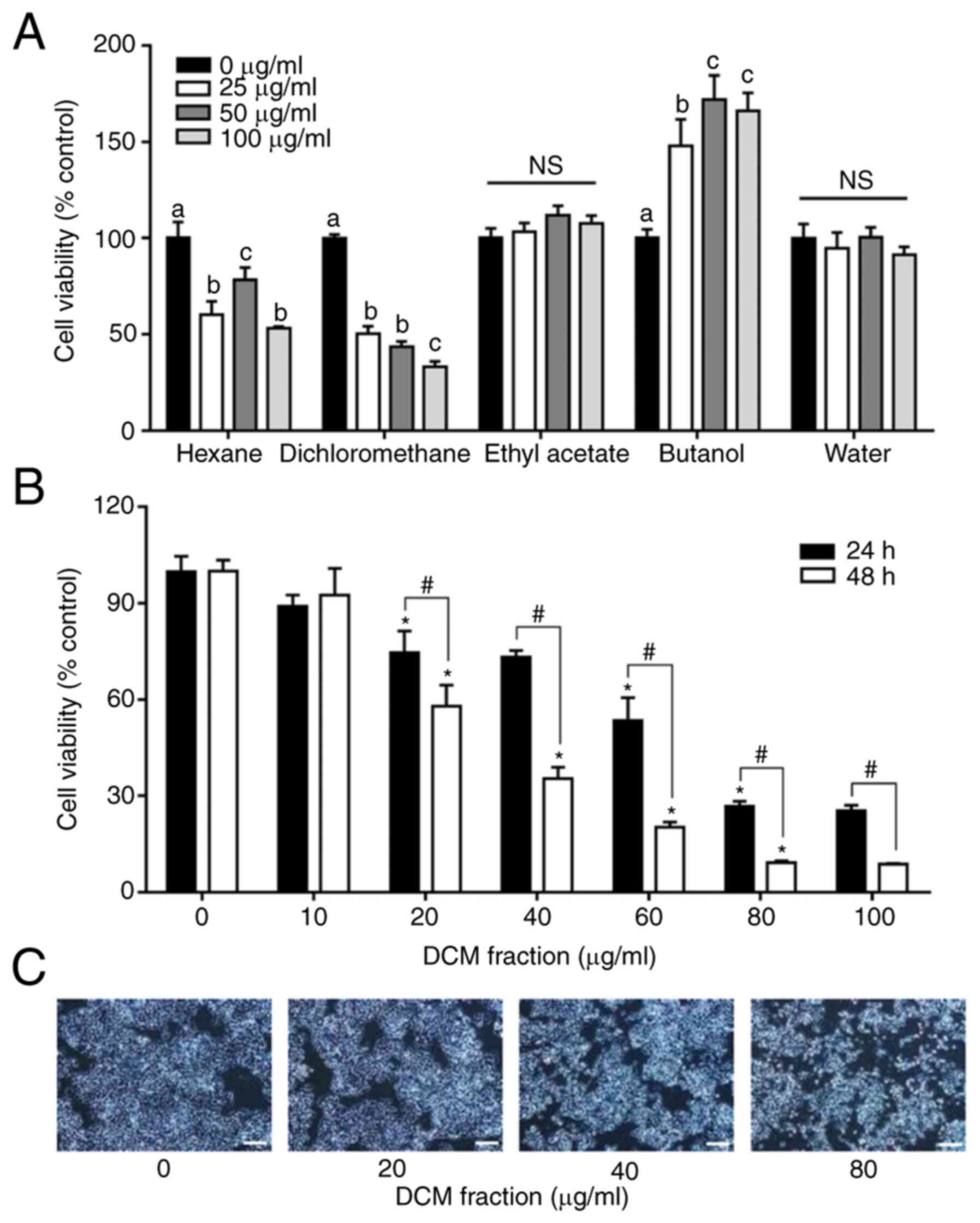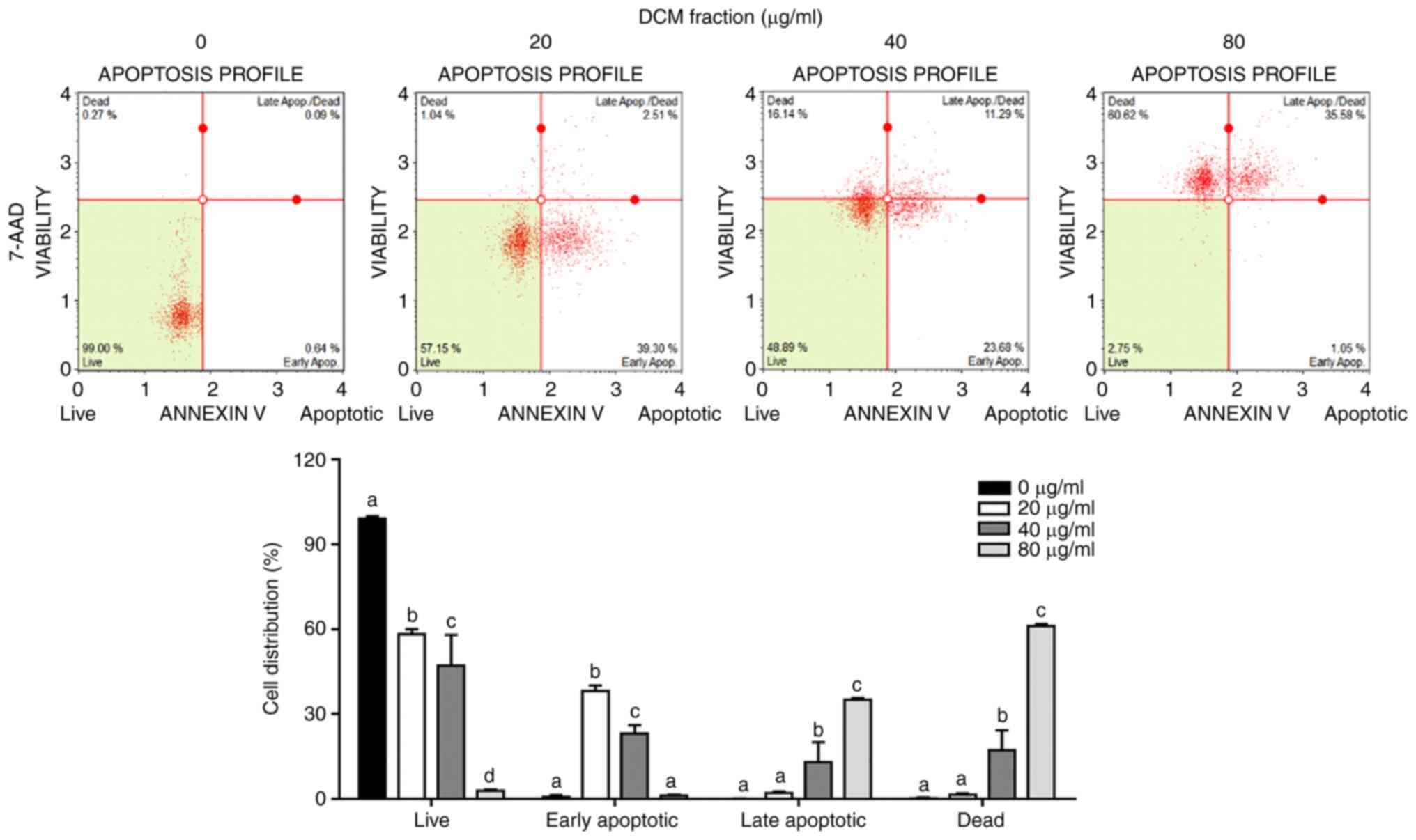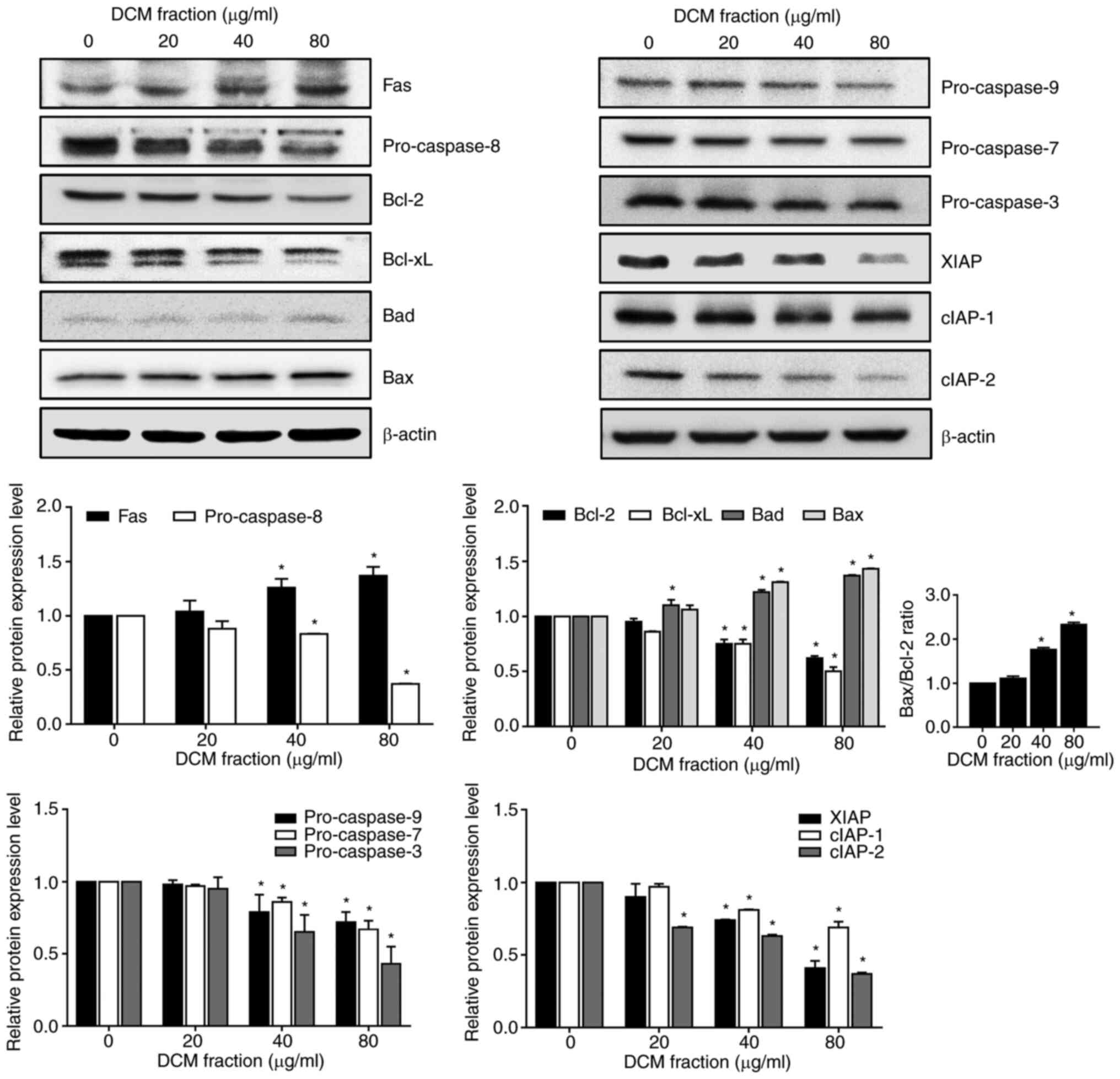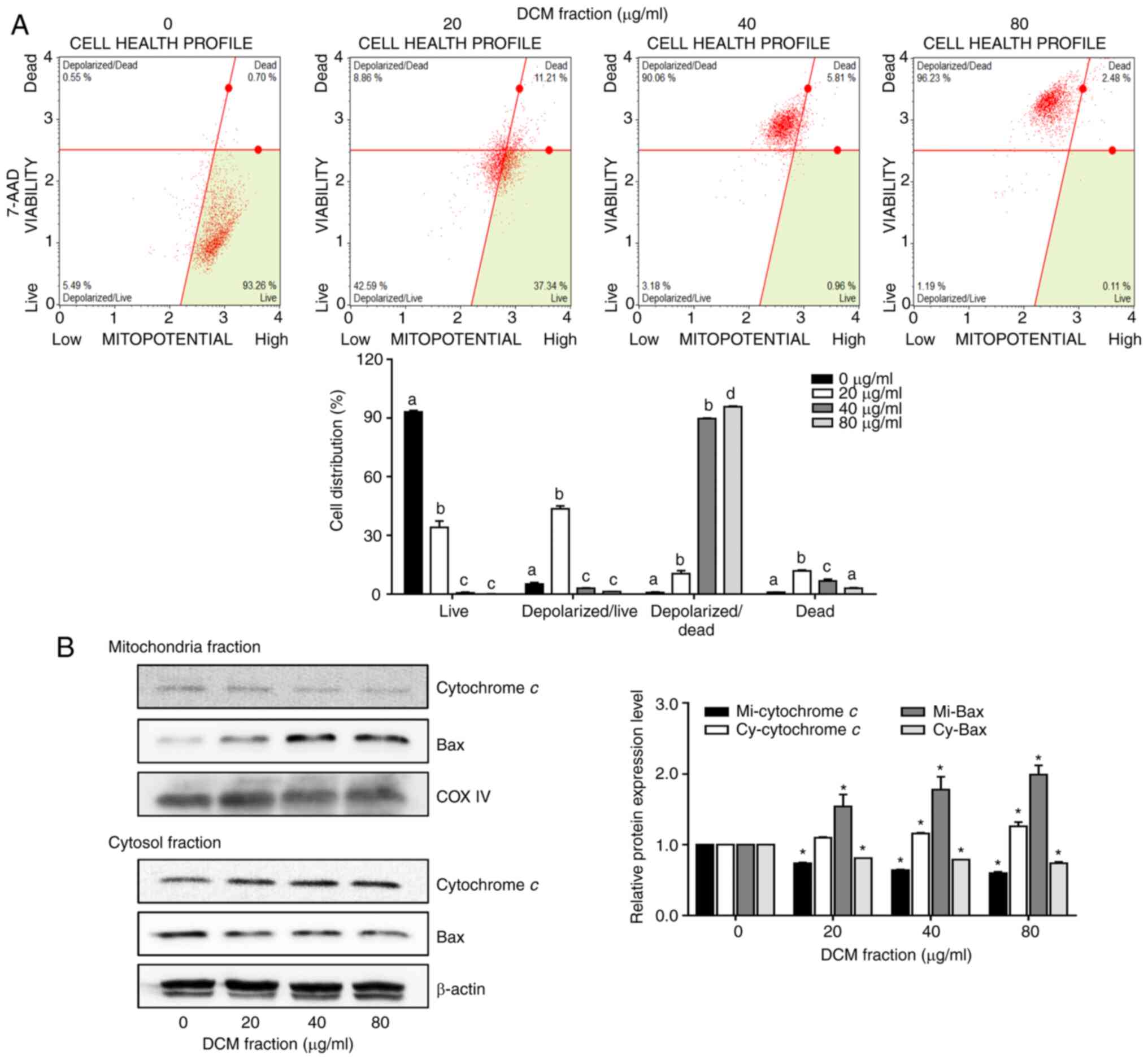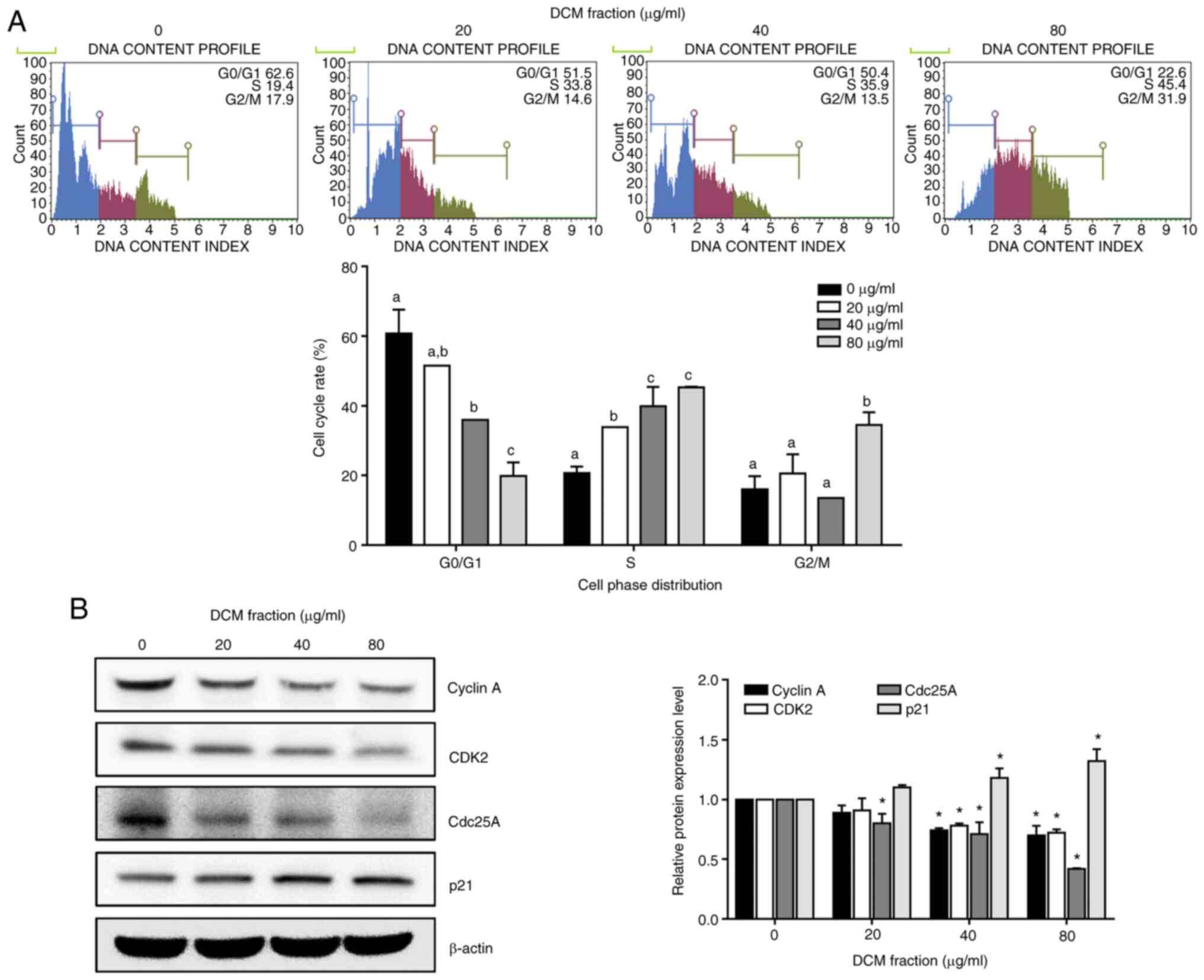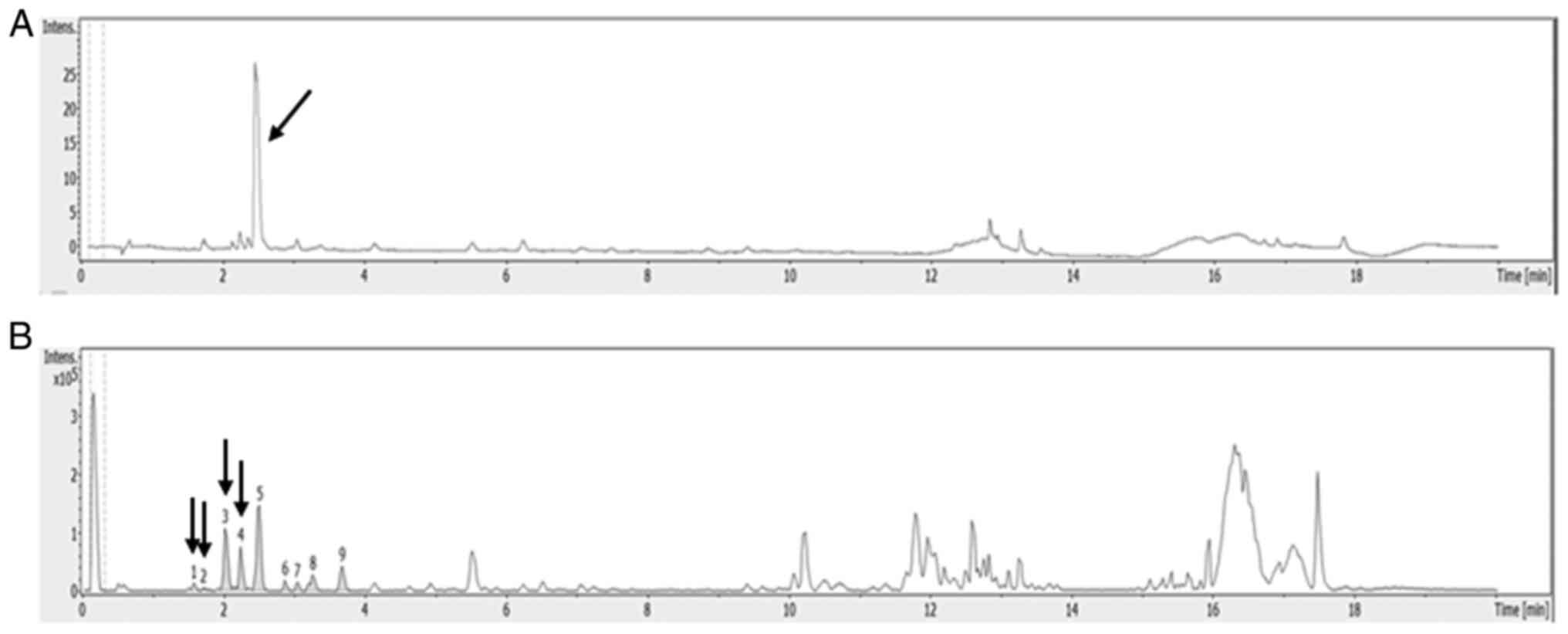|
1
|
Rawla P, Sunkara T and Barsouk A:
Epidemiology of colorectal cancer: Incidence, mortality, survival,
and risk factors. Prz Gastroenterol. 14:89–103. 2019.PubMed/NCBI
|
|
2
|
Cancer Trends Progress Report; Colorectal
Cancer Treatment. National Cancer Institute; 2020
|
|
3
|
Xie YH, Chen YX and Fang JY: Comprehensive
review of targeted therapy for colorectal cancer. Signal Transduct
Target Ther. 5:222020. View Article : Google Scholar : PubMed/NCBI
|
|
4
|
Pandey R, Singh PK and Shrivastava AK:
Seaweeds: Potential candidates in human colon cancer therapy. Colon
Cancer Diagnosis Ther. Jun 5–2021.(Epub ahead of print). doi:
10.1007/978-3-030-64668-4_13. View Article : Google Scholar
|
|
5
|
Zhao Y and Jiang Q: Roles of the
polyphenol-gut microbiota interaction in alleviating colitis and
preventing colitis-associated colorectal cancer. Adv Nutr.
12:546–565. 2021. View Article : Google Scholar : PubMed/NCBI
|
|
6
|
García-Lafuente A, Guillamón E, Villares
A, Rostagno MA and Martínez JA: Flavonoids as anti-inflammatory
agents: Implications in cancer and cardiovascular disease. Inflamm
Res. 58:537–552. 2009. View Article : Google Scholar : PubMed/NCBI
|
|
7
|
Akiyama Y, Kimura Y, Enatsu R, Mikami T,
Wanibuchi M and Mikuni N: Advantages and disadvantages of combined
chemotherapy with carmustine wafer and bevacizumab in patients with
newly diagnosed glioblastoma: A single-institutional experience.
World Neurosurg. 113:e508–e514. 2018. View Article : Google Scholar : PubMed/NCBI
|
|
8
|
Bar-Shalom R, Bergman M, Graossman S,
Azzam N, Sharvit L and Fares F: Inula viscosa extract inhibits
growth of colorectal cancer cells in vitro and in vivo through
induction of apoptosis. Front Oncol. 9:2272019. View Article : Google Scholar : PubMed/NCBI
|
|
9
|
Bravo L: Polyphenols: Chemistry dietary
sources metabolism nutritional significance. Nutr Rev. 56:317–333.
1998. View Article : Google Scholar : PubMed/NCBI
|
|
10
|
Moreira H, Slezak A, Szyjka A, Oszmianski
J and Gasiorowski K: Antioxidant and cancer chemopreventive
activities of cistus and pomegranate polyphenols. Acta Pol Pharm.
74:688–698. 2017.PubMed/NCBI
|
|
11
|
del Mar Blanquer-Rosselló M,
Hernández-López R, Roca P, Oliver J and Valle A: Resveratrol
induces mitochondrial respiration and apoptosis in SW620 colon
cancer cells. Biochim Biophys Acta Gen Sugj. 1861:431–440. 2017.
View Article : Google Scholar : PubMed/NCBI
|
|
12
|
Kim IH and Nam TJ: Fucoidan downregulates
insulin-like growth factor-I receptor levels in HT-29 human colon
cancer cells. Oncol Rep. 39:1516–1522. 2018.PubMed/NCBI
|
|
13
|
Kim IH, Kwon MJ and Nam TJ: Differences in
cell death and cell cycle following fucoidan treatment in
high-density HT-29 colon cancer cells. Mol Med Rep. 15:4116–4122.
2017. View Article : Google Scholar : PubMed/NCBI
|
|
14
|
Bae CY, Hwang JS, Bae JJ, Choi SC, Lim SH,
Choi DG, Kim JG and Choo YS: Physiological responses of
Calystegia soldanella under drought stress. J Ecol Environ.
36:255–265. 2013. View Article : Google Scholar
|
|
15
|
Bae KH: The Medicinal Plants of Korea.
Korea, Kyo-Hak publishing. (Seoul). 2000.
|
|
16
|
Lee YS, Kwak CG and Kim NW: Nutritional
characteristics of Calystegia japonica. Korean J Food
Preserv. 19:619–625. 2012. View Article : Google Scholar
|
|
17
|
Takagi S, Yamaki M, Masuda K and Kubota M:
Studies on the purgative drugs. IV. On the constituents of
Calystegia japonica Choisy (author's transl). Yakugaku
Zasshi. 97:1369–1371. 1977.(In Japanese). View Article : Google Scholar : PubMed/NCBI
|
|
18
|
Kim Y, Min HY, Park HJ, Lee EJ, Park EJ,
Hwang HJ, Jin C, Lee YS and Lee SK: Suppressive effects of nitric
oxide production and inducible nitric oxide synthase (iNOS) gene
expression by Calystegia soldanella methanol extract on
lipopolysaccharide-activated RAW 264.7 cells. Eur J Cancer Prev.
13:419–424. 2004. View Article : Google Scholar : PubMed/NCBI
|
|
19
|
Huang Z and Feng C: Experimental study on
anti-inflammatory and analgesic effects of water extracts of
Calystegia soldanella. Chin Arch Tradit Chin Med.
6:72010.
|
|
20
|
Lee JI, Kim IH, Choi YH, Kim EY and Nam
TJ: PTP1B inhibitory effect of alkyl p-coumarates from
Calystegia soldanella. Nat Prod Commun. 9:1585–1588.
2014.PubMed/NCBI
|
|
21
|
Nidiry ES, Ganeshan G and Lokesha AN:
Antifungal activity and isomerization of octadecyl p-coumarates
from Ipomoea carnea subsp. fistulosa. Nat Prod Commun.
6:1889–1892. 2011.PubMed/NCBI
|
|
22
|
Ono M, Kanemaru Y, Yasuda S, Okawa M,
Kinjo J, Miyashita H, Yokomizo K, Yoshimitsu H and Nohara T: A new
resin glycoside from Calystegia soldanella and its antiviral
activity towards herpes. Nat Prod Res. 31:2660–2664. 2017.
View Article : Google Scholar : PubMed/NCBI
|
|
23
|
Ono M, Takigawa A, Kanemaru Y, Kawakami G,
Kabata K, Okawa M, Kinjo J, Yokomizo K, Yoshimitsu H and Nohara T:
Calysolins V–IX, resin glycosides from Calystegia soldanella
and their antiviral activity toward herpes. Chem Pharm Bull
(Tokyo). 62:97–105. 2014. View Article : Google Scholar : PubMed/NCBI
|
|
24
|
Ono M, Kawakami G, Takigawa A, Kabata K,
Okawa M, Kinjo J, Yokomizo K, Yoshimitsu H and Nohara T: Calysolins
X–XIII, resin glycosides from Calystegia soldanella, and
their antiviral activity toward herpes simplex virus. Chem Pharm
Bull (Tokyo). 62:839–844. 2014. View Article : Google Scholar : PubMed/NCBI
|
|
25
|
Ono M, Takigawa A, Muto H, Kabata K, Okawa
M, Kinjo J, Yokomizo K, Yoshimitsu H and Nohara T: Antiviral
activity of four new resin glycosides calysolins XIV–XVII from
Calystegia soldanella against Herpes Simplex Virus. Chem
Pharm Bull (Tokyo). 63:641–648. 2015. View Article : Google Scholar : PubMed/NCBI
|
|
26
|
Min HY, Kim Y, Lee EJ, Hwang HJ, Park EJ
and Lee SK: Cytotoxic activities of indigenous plant extracts in
cultured human cancer cells. Nat Prod Sci. 8:170–172. 2002.
|
|
27
|
Lee JI, Kim IH and Nam TJ: Crude extract
and solvent fractions of Calystegia soldanella induce G1 and
S phase arrest of the cell cycle in HepG2 cells. Int J Oncol.
50:414–420. 2017. View Article : Google Scholar : PubMed/NCBI
|
|
28
|
Ly JD, Grubb DR and Lawen A: The
mitochondrial membrane potential (deltapsi(m)) in apoptosis; an
update. Apoptosis. 8:115–128. 2003. View Article : Google Scholar : PubMed/NCBI
|
|
29
|
Gottlieb E, Armour SM, Harris MH and
Thompson CB: Mitochondrial membrane potential regulates matrix
configuration and cytochrome c release during apoptosis. Cell Death
Differ. 10:709–717. 2003. View Article : Google Scholar : PubMed/NCBI
|
|
30
|
Yang J, Cao L, Li Y, Liu H, Zhang M, Ma H,
Wang B, Yuan X and Li Q: Gracillin isolated from Reineckia
carnea induces apoptosis of A549 cells via the mitochondrial
pathway. Drug Des Devel Ther. 15:233–243. 2021. View Article : Google Scholar : PubMed/NCBI
|
|
31
|
Christensen ME, Jansen ES, Sanchez W and
Waterhouse NJ: Flow cytometry-based assays for the measurement of
apoptosis-associated mitochondrial membrane depolarisation and
cytochrome c release. Methods. 61:138–145. 2013. View Article : Google Scholar : PubMed/NCBI
|
|
32
|
Mosca L, Pagano M, Pecoraro A,
Borzacchiello L, Mele L, Cacciapuoti G, Porcelli M, Russo G and
Russo A: S-Adenosyl-L-methionine overcomes uL3-mediated drug
resistance in p53 deleted colon cancer cells. Int J Mol Sci.
22:1032020. View Article : Google Scholar : PubMed/NCBI
|
|
33
|
Lu SC and Mato JM: S-Adenosylmethionine in
cell growth, apoptosis and liver cancer. J Gastroenterol Hepatol.
23 (Suppl 1):S73–S77. 2008. View Article : Google Scholar : PubMed/NCBI
|
|
34
|
Cave DD, Desiderio V, Mosca L, Ilisso CP,
Mele L, Caraglia M, Cacciapuoti G and Porcelli M:
S-Adenosylmethionine-mediated apoptosis is potentiated by autophagy
inhibition induced by chloroquine in human breast cancer cells. J
Cell Physiol. 233:1370–1383. 2018. View Article : Google Scholar : PubMed/NCBI
|
|
35
|
Ilisso CP, Delle Cave D, Mosca L, Pagano
M, Coppola A, Mele L, Caraglia M, Cacciapuoti G and Porcelli M:
S-Adenosylmethionine regulates apoptosis and autophagy in MCF-7
breast cancer cells through the modulation of specific microRNAs.
Cancer Cell Int. 18:1972018. View Article : Google Scholar : PubMed/NCBI
|
|
36
|
Mosca L, Minopoli M, Pagano M, Vitiello F,
Carriero MV, Cacciapuoti G and Porcelli M: Effects of
S-adenosyl-L-methionine on the invasion and migration of head and
neck squamous cancer cells and analysis of the underlying
mechanisms. Int J Oncol. 56:1212–1224. 2020.PubMed/NCBI
|
|
37
|
D'Arcy MS: Cell death: A review of the
major forms of apoptosis, necrosis and autophagy. Cell Biol Int.
43:582–592. 2019. View Article : Google Scholar : PubMed/NCBI
|
|
38
|
Elmore S: Apoptosis: A review of
programmed cell death. Toxicol Pathol. 35:495–516. 2007. View Article : Google Scholar : PubMed/NCBI
|
|
39
|
Pistritto G, Trisciuoglio D, Ceci C,
Garufi A and D'Orazi G: Apoptosis as anticancer mechanism: Function
and dysfunction of its modulators and targeted therapeutic
strategies. Aging (Albany NY). 8:603–619. 2016. View Article : Google Scholar : PubMed/NCBI
|
|
40
|
Goldar S, Khaniani MS, Derakhshan SM and
Baradaran B: Molecular mechanisms of apoptosis and roles in cancer
development and treatment. Asian Pac J Cancer Prev. 16:2129–2144.
2015. View Article : Google Scholar : PubMed/NCBI
|
|
41
|
Pan Y, Ye C, Tian Q, Yan S, Zeng X, Xiao
C, Wang L and Wang H: miR-145 suppresses the proliferation,
invasion and migration of NSCLC cells by regulating the BAX/BCL-2
ratio and the caspase-3 cascade. Oncol Lett. 15:4337–4343.
2018.PubMed/NCBI
|
|
42
|
Knight T, Luedtke D, Edwards H, Taub JW
and Ge Y: A delicate balance-The Bcl-2 family and its role in
apoptosis, oncogenesis, and cancer therapeutics. Biochem Pharmacol.
162:250–261. 2019. View Article : Google Scholar : PubMed/NCBI
|
|
43
|
Orrenius S: Mitochondrial regulation of
apoptotic cell death. Toxicol Lett. 149:19–23. 2004. View Article : Google Scholar : PubMed/NCBI
|
|
44
|
Scorrano L and Korsmeyer SJ: Mechanisms of
cytochrome c release by proapoptotic BCL-2 family members. Biochem
Biophys Res Commun. 304:437–444. 2003. View Article : Google Scholar : PubMed/NCBI
|
|
45
|
Meeran SM and Katiyar SK: Grape seed
proanthocyanidins promote apoptosis in human epidermoid carcinoma
A431 cells through alterations in Cdki-Cdk-cyclin cascade, and
caspase-3 activation via loss of mitochondrial membrane potential.
Exp Dermatol. 16:405–415. 2007. View Article : Google Scholar : PubMed/NCBI
|
|
46
|
Siu WP, Pun PB, Latchoumycandane C and
Boelsterli UA: Bax-mediated mitochondrial outer membrane
permeabilization (MOMP), distinct from the mitochondrial
permeability transition, is a key mechanism in diclofenac-induced
hepatocyte injury: Multiple protective roles of cyclosporin A.
Toxicol Appl Pharmacol. 227:451–461. 2008. View Article : Google Scholar : PubMed/NCBI
|
|
47
|
Ohtsuka T, Buchsbaum D, Oliver P, Makhija
S, Kimberly R and Zhou T: Synergistic induction of tumor cell
apoptosis by death receptor antibody and chemotherapy agent through
JNK/p38 and mitochondrial death pathway. Oncogene. 22:2034–2044.
2003. View Article : Google Scholar : PubMed/NCBI
|
|
48
|
Wang X, Lu X, Zhu R, Zhang K, Li S, Chen Z
and Li L: Betulinic acid induces apoptosis in differentiated PC12
cells via ROS-mediated mitochondrial pathway. Neurochem Res.
42:1130–1140. 2017. View Article : Google Scholar : PubMed/NCBI
|
|
49
|
Estaquier J, Vallette F, Vayssiere JL and
Mignotte B: The mitochondrial pathways of apoptosis. Adv Exp Med
Biol. 942:157–183. 2012. View Article : Google Scholar : PubMed/NCBI
|
|
50
|
Pucci B, Kasten M and Giordano A: Cell
cycle and apoptosis. Neoplasia. 2:291–299. 2000. View Article : Google Scholar : PubMed/NCBI
|
|
51
|
Canavese M, Santo L and Raje N: Cyclin
dependent kinases in cancer: Potential for therapeutic
intervention. Cancer Biol Ther. 13:451–457. 2012. View Article : Google Scholar : PubMed/NCBI
|
|
52
|
Sperka T, Wang J and Rudolph KL: DNA
damage checkpoints in stem cells, ageing and cancer. Nat Rev Mol
Cell Biol. 13:579–590. 2012. View Article : Google Scholar : PubMed/NCBI
|
|
53
|
George Rosenker KM, Paquette WD, Johnston
PA, Sharlow ER, Vogt A, Bakan A, Lazo JS and Wipf P: Synthesis and
biological evaluation of 3-aminoisoquinolin-1(2H)-one based
inhibitors of the dual-specificity phosphatase Cdc25B. Bioorg Med
Chem. 23:2810–2818. 2015. View Article : Google Scholar : PubMed/NCBI
|
|
54
|
Tilaoui M, Mouse HA, Jaafari A and Zyad A:
Differential effect of artemisinin against cancer cell lines. Nat
Prod Bioprospect. 4:189–196. 2014. View Article : Google Scholar : PubMed/NCBI
|
|
55
|
Zhu H, Zhang L, Wu S, Teraishi F, Davis
JJ, Jacob D and Fang B: Induction of S-phase arrest and p21
overexpression by a small molecule 2-[[3-(2,3-dichlorophenoxy)
propyl]amino]ethanol in correlation with activation of ERK.
Oncogene. 23:4984–4992. 2004. View Article : Google Scholar : PubMed/NCBI
|
|
56
|
Ahn NR, Ko JM and Cha HC: Comparison of
flavonoid profiles between leaves and stems of Calystegia
soldanella and Calystegia japonica. Am J Plant Sci.
3:1073–1076. 2012. View Article : Google Scholar
|
|
57
|
Al Aaraj L, Hayar B, Jaber Z, Saad W,
Saliba NA, Darwiche N and Ghaddar T: The effect of different ester
chain modifications of two guaianolides for inhibition of
colorectal cancer cell growth. Molecules. 26:54812021. View Article : Google Scholar : PubMed/NCBI
|
|
58
|
Takayama T, Miyanishi K, Hayashi T, Sato Y
and Niitsu Y: Colorectal cancer: Genetics of development and
metastasis. J Gastroenterol. 41:185–192. 2006. View Article : Google Scholar : PubMed/NCBI
|
|
59
|
Nakayama M and Oshima M: Mutant p53 in
colon cancer. J Mol Cell Biol. 11:267–276. 2019. View Article : Google Scholar : PubMed/NCBI
|
|
60
|
Li XL, Zhou J, Chen ZR and Chng WJ: p53
mutations in colorectal cancer-molecular pathogenesis and
pharmacological reactivation. World J Gastroenterol. 21:84–93.
2015. View Article : Google Scholar : PubMed/NCBI
|
|
61
|
Murai Y, Setoguchi H, Ono E and Iwashina
T: Flavonoids and their qualitative variation in Calystegia
soldanella and related species (Convolvulaceae). Nat Prod
Commun. 10:429–432. 2015.PubMed/NCBI
|
|
62
|
Abotaleb M, Liskova A, Kubatka P and
Busselberg D: Therapeutic potential of plant phenolic acids in the
treatment of cancer. Biomolecules. 10:2212020. View Article : Google Scholar : PubMed/NCBI
|
|
63
|
Anantharaju PG, Gowda PC, Vimalambike MG
and Madhunapantula SV: An overview on the role of dietary phenolics
for the treatment of cancers. Nutr J. 15:992016. View Article : Google Scholar : PubMed/NCBI
|
|
64
|
Jaganathan SK, Supriyanto E and Mandal M:
Events associated with apoptotic effect of p-coumaric acid in
HCT-15 colon cancer cells. World J Gastroenterol. 19:7726–7734.
2013. View Article : Google Scholar : PubMed/NCBI
|
|
65
|
Janicke B, Hegardt C, Korgh M, Onning G,
Akesson B, Cirenajwis HM and Oredsson SM: The antiproliferative
effect of dietary fiber phenolic compounds ferulic acid and
p-coumaric acid on the cell cycle of Caco-2 cells. Nutr Cancer.
63:611–622. 2011. View Article : Google Scholar : PubMed/NCBI
|
|
66
|
Janicke B, Onning G and Oredsson SM:
Differential effects of ferulic acid and p-coumaric acid on S phase
distribution and length of S phase in the human colonic cell line
Caco-2. J Agric Food Chem. 53:6658–6665. 2005. View Article : Google Scholar : PubMed/NCBI
|
|
67
|
García-Gutiérrez N, Maldonado-Celis ME,
Rojas-López M, Loarca-Piñaa GF and Campos-Vega R: The fermented
non-digestible fraction of spent coffee grounds induces apoptosis
in human colon cancer cells (SW480). J Funct Foods. 30:237–246.
2017. View Article : Google Scholar
|
|
68
|
Ekbatan SS, Li XQ, Ghorbani M, Azadi B and
Kubow S: Chlorogenic acid and its microbial metabolites exert
anti-proliferative effects, S-phase cell-cycle arrest and apoptosis
in human colon cancer Caco-2 cells. Int J Mol Sci. 19:7232018.
View Article : Google Scholar
|
|
69
|
Hernández-Arriaga AM, Oomah BD and
Campos-Vega R: Microbiota source impact in vitro metabolite colonic
production and anti-proliferative effect of spent coffee grounds on
human colon cancer cells (HT-29). Food Res Int. 97:191–198. 2017.
View Article : Google Scholar : PubMed/NCBI
|















